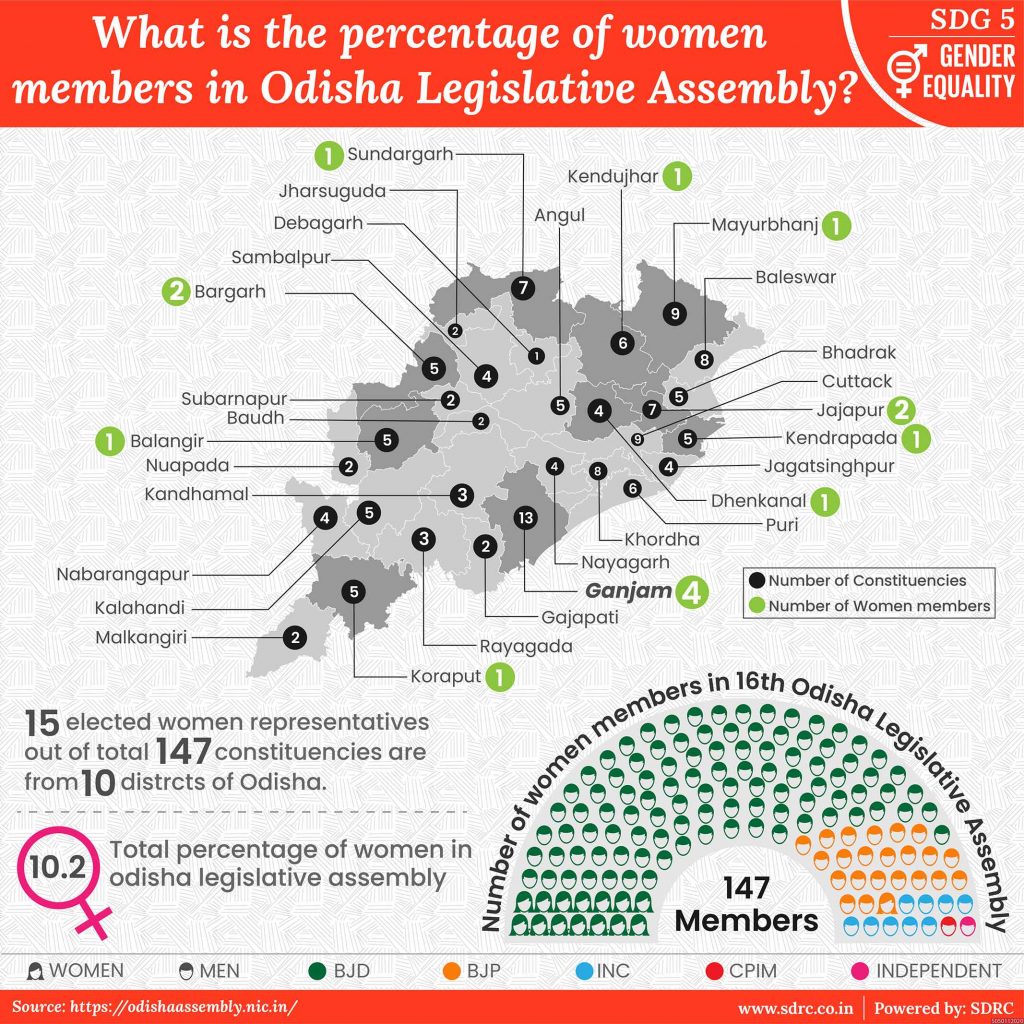“In politics, if you want anything said, ask a man. If you want anything done, ask a woman.” _ Margaret Thatcher
Participation of women in politics not only promotes gender equality but also diversity. A Korn Ferry Hay Group study conducted in 2016 revealed that women fared better than men in inspiring action, persuasion, mentoring, leadership, and adaptability.
Bestowed with high emotional intelligence, empathy, and communication skills, women are good leaders.
However, despite all these attributes, their participation in Indian politics is extremely low.
How many women MLAs in Odisha?
Presently, the 147-member Odisha Legislative Assembly has 15 women members (10. 2%). The shocking fact is that out of 30 districts, only 10 account for all elected members.
With 4 women MLAs, Ganjam accounts for the highest number of seats, followed by Bargarh and Jajapur – 2 each. Koraput, Dhenkanal, Kendrapara, Mayurbhanj, Kendujhar, Sundergarh and Balangir contribute one seat each.
A comparative study:
In 1993-94, women’s representation in the Odisha Legislative Assembly was at 4.76%. It surged to 5.44% in 1995-99.
Between 2000 and 2003, the number of women MLAs jumped to 8.84%, but, in 2004-08, it marginally slid to 7.48%.
In the 2009 election, it slumped to its lowest 4.76%. However, it jumped to 7.48% in 2014 election and remained there till April 2019.
Where does Odisha stands compared to other states?
Odisha ranks eighth in terms of percentage of women representation.
Haryana and Chhattisgarh rank top with 14.44%. Out of total 90 MLAs in their respective assemblies, 13 are women.
West Bengal ranks 2nd with 13.6% of women in its legislative assembly. Out of 294 MLAs, 40 are women.
Bihar ranks 3rd with 11.93% of women in its assembly, 29 of 243 MLAs are women.
Rajasthan ranks 4th with 11.5% women in the state legislative assembly. Of 200 MLAs, 23 are women.
Andhra Pradesh ranks 5th with 20 women MLAs of 175 seats, 11.42%.
Delhi, after recently concluded assembly elections, ranks 6th with 8 women MLAs out of 70 seats, giving it a percentage of 11.4%.
Jharkhand ranks 7th with 11.11% women in its legislative assembly. Nine out of 81 MLAs are women.
Uttar Pradesh ranks 9th with 10.17% women in its assembly. Out of 403 total seats it has 41 women MLAs, the highest in the country.
Madhya Pradesh ranks 10th with 21 women MLAs out of 230 seats (9.13%).
Mizoram and Nagaland rank the lowest with no women MLAs in their legislative assemblies.
What the state government is doing about it?
On November 20, 2018, the Odisha assembly passed a resolution proposing 33% reservation for women in the Parliament and the assemblies by a vote voice.
In March 2019, just before the state elections, Odisha CM Naveen Patnaik announced that his party BJD (Biju Janata Dal) will reserve 33% seats for women in the allocation of Lok Sabha tickets to the parliament.
What can be done to improve the situation?
Reservation: It’s high time that every state assembly set aside 33% of total seats for women candidates.
Minimum qualification: After reservation, setting a minimum qualification will encourage women to get seats based on their merits and not due to political clout or nepotism. States should also incentivize meritorious women to be in politics.
Encouragement and mentoring: Political parties and the society must create an encouraging environment that will inspire women to be in politics. Senior and experienced politicians should also mentor women in their parties to be efficient and effective.
Cleaning up the system: It’s no secret that a few dubious elements exist in some political parties. They must be ousted, and the credibility of all members must be verified to determine they can get along and work well with women politicians, bureaucrats and party workers.
Create a safe and favourable work environment: The work environment for women politicians and aspirant candidates must be safe and favourable for them to work at their level best. All steps should be ensured to protect them from physical, mental or sexual harassment.
Such steps are necessary not just for the sake of gender equity but also for good governance. If Odisha adopts these, it will mark a significant change.
Download the snapshot here.




